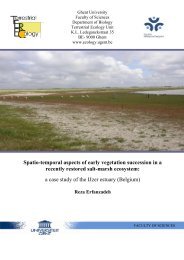PhD Arthur Decae 2010 - Ghent Ecology - Universiteit Gent
PhD Arthur Decae 2010 - Ghent Ecology - Universiteit Gent
PhD Arthur Decae 2010 - Ghent Ecology - Universiteit Gent
You also want an ePaper? Increase the reach of your titles
YUMPU automatically turns print PDFs into web optimized ePapers that Google loves.
Raven & Schwendinger 1995, Iberesia <strong>Decae</strong> & Cardoso 2005) and 23 new species (Hu & Li<br />
1987; Zonstein 1987, 2000, 2007, 2009; Dunin 1988; <strong>Decae</strong> 1995, 2005; Raven &<br />
Schwendinger 1995; Zhu, Zhang & Zhang 1999; Shimojana & Haupt 2000; Song, Zhu &<br />
Chen 2001; Xu & Yin 2002; <strong>Decae</strong> & Cardoso 2005; Lazarov 2005; <strong>Decae</strong>, Cardoso &<br />
Selden 2007; Kovblyuk & Ponomarev 2008). All this taxonomic activity has produced<br />
important new information on the patterns of diversity and distribution of the Nemesiinae.<br />
The picture emerging is that, at the genus level, the subfamily is primarily distributed in a<br />
longitudinal geographic diversity pattern with the genus Sinopesa in the Far East 25 , Raveniola<br />
in eastern and Central Asia, Brachythele in Asia Minor and Eastern Europe, Nemesia in the<br />
Mediterranean and Iberesia in the Iberian and Atlantic zones of the distribution range<br />
(Fig.17). Future discoveries and descriptions have to reveal how accurate and complete this<br />
longitudinal diversity pattern is, and if it is also visible at higher sub-generic and supraspecific<br />
taxonomic levels. Recently Zonstein (1987, 2009) and <strong>Decae</strong> & Di Franco (2005),<br />
following Simon (1892, 1914), have reported the existence of distinct species groups in<br />
Raveniola and Nemesia. Here the existence of a longitudinally organized diversity pattern at<br />
the sub-generic and supra-specific in Nemesia is confirmed.<br />
Fig. 17 The known distribution of Nemesiinae genera based on published distribution<br />
records. Lilac circles = Brachythele, blue squares = Iberesia, orange triangles = Nemesia,<br />
green squares = Raveniola, red circles = Sinopesa.<br />
Acknowledgements<br />
25 The one Nemesia record in Eastern China (Fig. 17) is Nemesia sinensis Pocock 1901. The genetic identity of<br />
this species needs verification.










